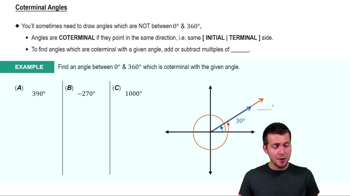Textbook Question
Find the reference angle for each angle.
205°
16
views
 Verified step by step guidance
Verified step by step guidance



Find the reference angle for each angle.
205°
Find a cofunction with the same value as the given expression.
cos (3𝜋/8)
The unit circle has been divided into twelve equal arcs, corresponding to t-values of
0, 𝜋/6, 𝜋/3, 𝜋/2, 2𝜋/3, 5𝜋/6, 𝜋, 7𝜋/6, 4𝜋/3, 3𝜋/2, 5𝜋/3, 11𝜋/6, and 2𝜋
Use the (x,y) coordinates in the figure to find the value of each trigonometric function at the indicated real number, t, or state that the expression is undefined.
<IMAGE>
sin 𝜋/6